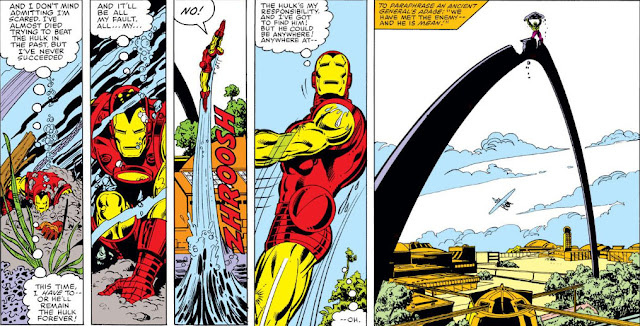We've already seen Part 1 of a story where Tony Stark attempted to help Bruce Banner in preventing his transformations into the incredible Hulk. It seems we have only to take a look at the cover of the following issue to see how that worked out.
Yet we've jumped a little bit ahead, because there's more to the story. After being taken into Stark's custody following a rampage as the Hulk, Banner thought of the idea of an implant that would regulate his heartbeat, so that, no matter how agitated he became in times of stress, his transformation would never be triggered. Stark grasped the concept and took it from there--enlisting help from his staff to construct the implant, as well as the services of Dr. Erica Sondheim, the world's foremost laser surgeon, to operate on Banner and insert the device in Banner's chest.
Afterward, all signs pointed to the experiment being a success--until a military attempt to take Banner into custody resulted in a grenade being triggered near the fleeing scientist. And for a few seconds, everyone feared the worst--that Banner's implant had failed, and that the Hulk was once again free to wreak havoc. Yet when the dust settled, it was clear the device had functioned as designed--but that Banner's transformation took place on levels other than just physically.
But, despite the glitch in this plan facing them now, Stark and his team are about to find themselves in greater danger from "the man who would be Hulk."
It's Banner's immediate problem, however startling it is to Stark and the others, that naturally must first be diagnosed and hopefully alleviated. To that end, Stark contacts Gamma Base, and receives crucial information on Banner's condition that we're already aware of.
Since it's Banner's mind that's the linchpin of his condition and thus the key to any solution, it stands to reason that calming the Hulk's rage would still trigger a "transformation" back to Banner, whatever form that rage now takes. And so Stark is able to at least overcome that hurdle with the technology at his disposal.
Once Banner is left to quietly rest after his experience (but remaining in restraints, to be on the safe side), Sondheim makes clear the fact that, due to the alarming symptoms she's noticed manifesting in Banner, their troubles are just beginning. But "alarming" takes on a whole new meaning when Stark connects the dots and discovers the flaw in the design of Banner's implant.
In essence, the regulator's effects are being negated by the radiation it's constantly absorbing from Banner's own system. Writer David Michelinie's cause of this problem is likely meant to side-step scrutiny and provide a fast track to the story's action spiking, but his reasoning is specious. Whatever amount of radiation the device is absorbing, it's designed to keep Banner's heartbeat at X number of beats per minute--not to raise that level. As long as it does its job, whatever power source sustains its operation is irrelevant. It might well overload and burn itself out if Banner's gamma radiation overly affects it, but not reprogram itself. (Unless one of our alert readers at the PPC cares to go for a no-prize and explain Mr. Michelinie's thinking on this?)
Not that the discrepancy makes any difference to Banner in his current state:
This experiment now a complete bust, Stark, as Iron Man, must try to contain the damage. And since that amounts to containing none other than the Hulk, who's now in a constant state of rage due to the runaway implant, he has his work cut out for him.
And so this life-or-death battle begins, with Iron Man's one hope for getting this situation under control--the possibility that the Hulk might be calmed sufficiently in order to transform back to Banner--now an impossibility. And in the heat of battle--a battle which Iron Man is all too quickly realizing might not go his way--Stark feels the weight of his mistake, and that whatever lives are lost will be his responsibility.
The turning point of the battle comes when the Hulk is diverted to the S.I. airfield, when Iron Man realizes that desperate steps must be taken to deal with the monster. And in a stunning sequence of panels by artist Jerry Bingham, we see a display of the power of Iron Man against a virtually unstoppable opponent, as we've seldom seen it before.
If you're wondering why in the world Michelinie gave Rhodey an exclamation having to do with ascots and well-diggers, I'm scratching my head right along with you. An ascot, from what I understand, is basically a less formal, more loose style of necktie which gets its name from the Royal Ascot horse race where it became a popular fashion.
Tied lower under the collar, ascots are traditionally worn inside the shirt; but they've also been worn outside, as our friends Ashton Kutcher and Colin Farrell respectively demonstrate:
(Ashton probably could have used a bit of assistance with his.)
As for its association with well-diggers, well, granted a well-digger would probably appreciate a little neck-warmth in that kind of environment, though it's a rare day when you'll spot a fashionable well-digger.
Iron Man, of course, is a little too warm right now, still sizzling from his ultimate effort that dropped the Hulk like a sack of potatoes. It's a triumph that those who witnessed it will likely be talking about for years to come. The only question is: Will Iron Man be around to enjoy his laurels?
COMING UP:
This story's epilogue: The Man In The Iron Coffin!
 | Invincible Iron Man #132 Script: David Michelinie Pencils: Jerry Bingham Inks: Bob Layton Letterer: Joe Rosen |























1 comment:
I wish they had kept the "Bruce Banner thinks he's the Hulk" thing around a few more issues. It's hilarious!
Post a Comment